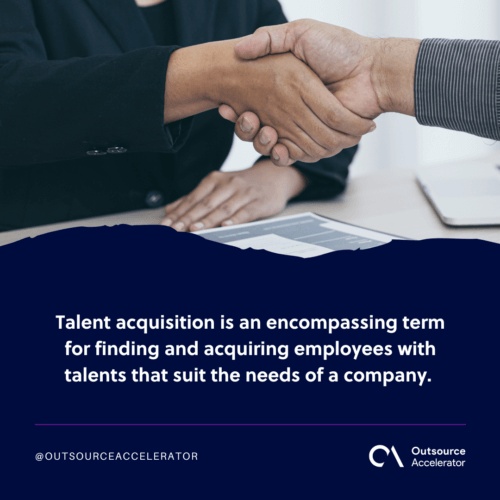Talent acquisition
Definition
What is talent acquisition?
Talent acquisition is an encompassing term for finding and acquiring employees with talents that suit the needs of a company. Just like recruitment, the process includes planning, analyzing, and job posting.
Talent acquisition is vital for every company as it locates a culture-fit person who can contribute to the company’s success. Hiring the right talent will improve the company’s productivity, decision-making, and morale.
With the right person, it is easier to maintain the stability of a business in a competitive market.
Difference between recruitment and talent acquisition
Filling vacancies is the core duty of recruitment. A company’s long-term strategy for identifying and recruiting specialists, leaders, and potential executives is known as talent acquisition.
Two of the most prevalent objectives of talent acquisition are the long-term planning of human resources and the identification of competent individuals for positions needing a specific set of competencies.

What does a talent acquisition specialist do?
To be a successful talent acquisition specialist, you should have extensive recruiting experience and the ability to find the right person for each position.
The common tasks in talent acquisition are:
- Identifying the company’s recruitment needs by working with internal divisions.
- Identifying the qualifications needed to fill open positions, as well as the profile of the ideal candidate.
- Using online firm career portals, recruiting websites, job boards, social platforms, and print advertising to find suitable recruits.
- Utilizing applicant tracking systems to streamline the hiring process.
- Conducting pre-interview tests through phone or email, as well as evaluations of applications.
Talent acquisition process
Talent acquisition can be a months-long process. As a general guideline, it comprises of four main steps:
Acquiring possible leads
The first step is getting access to a pool of candidates qualified to fill in the job vacancy. At this point, you want to make sure you’re using every channel available to find as many potential customers as possible.
Job descriptions must lay out exactly what the candidate must do and what experience and skills are needed. You can also use a professional website or platform for job seekers.
Choosing the proper interview questions
A candidate’s interview is crucial to ensure a successful hiring process. Human resources and recruiting managers need to be well-versed in interviewing techniques in order to select the best candidates for the position.
Preparation is the key for hiring managers to get the information they need from job interviews. It includes choosing the interviewing style, preparing relevant questions, and expressing questions correctly.
Conducting assessments
An IQ exam, an emotional intelligence test, and a personality test are additional tools for evaluating a candidate. Other companies may also include physical ability tests.
One of the best ways to evaluate candidates is to ask them to solve a real-world problem during the interview process. It’s important that the test and assessment do not discriminate and are still relevant to the organization’s objectives.
Choosing the best candidate
Even though recruiting and onboarding aren’t necessarily the responsibility of a talent acquisition team, they are the final and most important phase in the process of acquiring great employees.
When hiring, consider someone who has a long-term commitment to the company and is willing to grow with the firm. You should be able to see how prospects were scored before making your final hiring decision.

Effective talent acquisition strategies
In order for firms to secure the long-term success of their employees, they must handle talent acquisition strategically.
Here are the most effective practices in talent acquisition:
Create a solid talent acquisition strategy
A company’s talent acquisition strategy must be customized to meet the specific demands and objectives of the organization. After assessing your company’s talent acquisition scenario, you should set short-term, medium-term, and long-term improvement goals.
Management and HR should work together if you have access to data and statistics about the quality of your hiring process. With the information on hand, you can design a recruitment plan that will work with your existing process.
Practice flexibility and responsiveness
When it comes to recruiting new employees, your company’s demands will change based on a range of factors. It’s important to adjust your plan to fit your company’s needs for new employees.
Build a strong brand identity
Organizations with strong and well-known employer brands attract high-quality candidates. This means that companies must be clear about what they can give their employees in terms of work environment and benefits. The more clearly you establish your employer brand, the more likely you can attract top personnel.
Use data analytics
To find the right professionals, go through the hiring process and utilize the system’s maximum potential. It saves both time and money, while also making it easier to find and hire the best people possible.
Data analytics is one of the most important tools for talent acquisition. When it comes to recruiting, you don’t need a full-time data analyst, but you should be able to track the results.







 Independent
Independent




